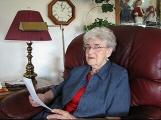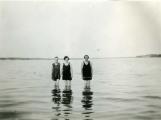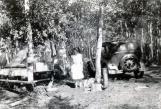2
Atton's Lake 1920 - 1940Atton's Lake lies in the centre of the Triple Lakes in the Cut Knife municipality. To the east of Atton's Lake lies Big Lake, the largest of the three and to the west lies McLellan's Lake, the smallest. The names of the largest and smallest have been changed for many, many years.
The district of Riding Hill, where I grew up, was five miles south of the lakes. Big Lake was popular to the residents of that district in the 1920's. It was a little closer to travel to as most traveling was done by horse-drawn vehicles over mere trails.
4
Big Lake, as I knew it, had only one beach of any size with any amount of shade trees. It was narrow, offering fine clean sand. One entered the lake cautiously not venturing far from the shore and always having children under strict supervision. Sudden drop-off holes were deep and there were no warning signs.Well do I remember bathing suits in that era. They were either all wool or all cotton. ..they were one piece with an over-skirt. They were anything but attractive when soaked with water. They hung and clung to the body from shoulder to knees. The wool was scratchy to sensitive skin.
6
As far as I am aware of, there was never more than one cabin there. It was a small log one built by Bert Martin, a Riding Hill resident, in approximately 1925. On completion of the cabin, Bert offered it to my cousin Toice McLain to be part of her Canadian Girls in Training (C.G.I.T.) church group camp that year. I, as a member, attended that camp with perhaps eight other girls and her mother was the camp mother.In approximately 1928 our family and friends chose to go to Atton's Lake in preference to Big Lake. The main beach was larger, the sand was comparable, and although there were holes they were farther out in the lake. It offered a much safer area for those who could not swim but enjoyed the fun in the water.
Young people did a lot of hiking in those days. I remember a group of us attempting to walk around Atton's Lake. We found the beach ended abruptly east and west of the main beach. We had to climb up wooded banks and proceed on trails above the water that lapped against the cut-away banks. The water level was very high. There was a narrow stretch of beach on the west side and a larger area of beach on the north shore but short scrawny trees offered no shade at all. It was very unattractive and desolate.
Hikers in July often returned with arms full of long stemmed orange prairie tiger lilies grown wild all through the trees. At that time they were very plentiful and there was no restrictions about picking them.
8
Frequently in July neighbors and others gathered at the lake for the afternoon and evening. There were no camp tables or other conveniences before 1930. At supper time prepared food baskets were brought out and a great variety of home-cooked food was placed on table cloths spread on the ground side by side. It was interesting to see how long the table sometimes became if unexpected picnickers happened along and were invited to join their cloth. Everyone had a robe to sit on - sharing and socializing was a way of life. Well do I remember before seating took place voices raised in thanksgiving as the standing group with bowed heads sang "Be present at our table Lord'.I have no recollection of cabins at Atton's Lake prior to 1930. Tent camping started in a low area with many tall poplar trees south east of the main beach.
In 1930 the municipality purchased 20 acres of land from William Atton of the Riding Hill district. It took in the lake and suitable areas for the development of a park. It was the start of the great depression decade so development was slow. The leasing of lots was one of the first projects and to my knowledge the first two cabins built were owned by Paul Margot and F.D. McKenzie of Cut Knife.
My family tent-camped a couple of times before leasing a lot in 1933. Lots leased for $2.50 at that time and remained at that rate for a long time. Our lot was number 36 for many years, until re-numbering took place, then it was changed to 143.
9
McLain Tenting at Atton's 19331933
Atton's Lake Campground; Atton's Lake, Saskatchewan, Canada
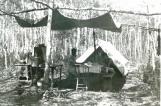 Credits:
Credits:Sleath, Ruby
10
People were allowed to put whatever type of building they could afford on their lots, no restrictions, consequently grain bins, storage sheds and other similar buildings were moved in. A few necessities in the public areas were added and appreciated such as wooden tables, benches, horseshoe pit, children's swings, a ball diamond with bleachers and a booth. Two bath-houses accommodated men and women bathers and a diving board was installed to mark the hole and to give experienced swimmers more depth in diving.Our family's first building was a one room shack. It could only accommodate a bed, a folding couch, two apple box crates with a division that served as a shelf to hold dishes, a wooden box with a hinged lid for grocery storage serving also as a bench. There were corrugated cardboard boxes of mother's home preserved meats, vegetables, fruits, jams and pickles in glass sealers stacked one upon the other - there was very little space to walk. Meals were prepared and eaten at a long wide wooden table my father built in front of the cabin with attached benches. Above it was a canvas canopy that had too many holes to keep out the rain but did offer shade. A small iron stove had a flat top surface large enough to boil a kettle, use a frying pan or a vegetable pot, one at a time. A cardboard lined hole in the ground with a wooden lid kept milk sweet and butter firm for short periods of time.
Many evenings were spent in group singing on our lot. Clayton had only to strum a few chords on his guitar or banjo - it was like a summons and campers wandered in from all directions, robes tucked under their arms for sitting on the ground. Occasionally other musical instruments were brought in. Often it was a mouth organ or a jews harp.
11
Municipal Park Camping Permit 1933Summer 1933
Atton's Lake Campground; Atton's Lake, Saskatchewan, Canada
 Credits:
Credits:Clayton McLain Memorial Museum
12
Around 1930, George Paterson, a Scout Master of a Boy Scout Troop in Unity, Sask. was encamped with his troop at M'cLellan's Lake. He came to Atton's Lake one day to see if he could arouse an interest in a weekly Saturday night bonfire and program that would involve his troop and the campers. It was agreeable with the campers so they and the troop gathered wood all week, piling it on the hill-side east of the ball diamond. Members of the troop went from camp to camp recording program items. The Scout Master organized the order of the program and at dusk with the hill-side covered with people the huge bonfire was lit and the program was on.The variety and talent displayed all evening held a very appreciative audience. The hearty applause encouraged all of us who took part and it was no surprise to anyone at the close of the program to hear an announcement of future weekly programs.
13
Afternoon at the Lake During the War YearsCirca 1941
Atton's Lake, Saskatchewan, Canada
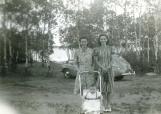 Credits:
Credits:Sleath, Ruby
14
Soldier's Bride at Quiet LakeCirca 1941
Main Beach, Atton's Lake, Saskatchewan, Canada
 Credits:
Credits:Sleath, Ruby
